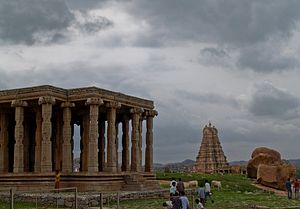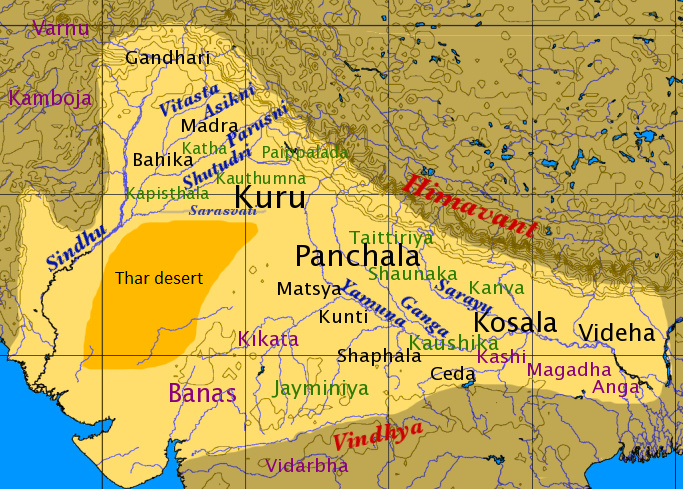That India is an extremely diverse country is a widely known, but nonetheless true, platitude. For convenience, India is usually interpreted through geographical categories, such as North India, Northeast India, West India, or South India.
Indians themselves have historically seen their subcontinent as compromising two major regions, which better reflects cultural and historical divisions in the regions: the Aryavarta and the Deccan. While these somewhat reflect the common understanding of there being a north-south division in India, Aryavarta and the Deccan do not map on exactly to the ideas of North and South India. These two regions are defined by distinct topographies and geologies, and as a result, different social patterns and agricultural patterns. The Deccan is distinct from South India — which is usually defined as the five Dravidian-language speaking states of peninsular India — in that it includes Goa, Maharashtra, Odisha, much of Chhattisgarh, and parts of Gujarat, Madhya Pradesh, and Jharkhand.
Traditionally, either the Vindhya Mountains or the Narmada River in central India have traditionally formed the boundary between northern and southern India, between Aryavrata and the Deccan. The ancient Indian text the Manusmriti from the first century of the common era defines Aryavarta as “the tract between the Himalaya and the Vindhya ranges, from the Eastern Sea [Bay of Bengal] to the Western Sea [Arabian Sea].” Interestingly, texts from before the Manusmriti put the eastern boundaries of Aryavarta around the confluence of the Ganges and Yamuna, leaving the ancient, relatively unorthodox (in the Hindu sense) kingdom of Magadh, today’s Bihar and Bengal — the homeland of Buddhism and Jainism — outside of Aryavarta. Modern Bengal is significantly different from the rest of northern India to this understanding to have some modern resonance.
Indeed, there are major differences between the historical Indian regions of Aryavarta and the Deccan, which are salient today. The Indo-Gangetic Plain which dominates Aryavarta has supported both a large and highly dense population, as well as empires that both swiftly expanded and fell due to the lack of topographic barriers. As the name suggests, Aryavarta was inhabited primarily by speakers of Indo-Aryan languages, and is the homeland of much of what is considered “standard” in Hinduism and Indian culture: Sanskrit, the reverence for the cow, an emphasis on vegetarianism as a sacred duty, well-defined caste divisions, worship of the god Rama, amongst other features. This is the classical Indian culture that emerged between 500 BCE and 500 CE, spanning the famed Mauryan and Gupta empires.
Culturally and politically, the Deccan is not just a southward extension of Aryavarta, but like Tibet and Southeast Asian societies, an adaptation of classical Indic civilization to a new environment. The word itself derives from Sanskrit dakshina, meaning south, south of Aryavarta. This does not make it any less Indian than Aryavarta, but it certainly makes it distinct. Dominated by empires such as the Satavahanas, Vatakatas, Rashtrakutas, Chalukyas, Cholas, Vijayanagara, and the Marathas, the Deccan has been home to many historically significant states that nonetheless have not attained the fame of the Ganges-based Mauryas, Guptas, Delhi Sultanate, and Mughals.
Much of the Deccan is arid and hilly, a triangular plateau that rises from central India toward its southern tip, flanked by two mountain ranges, the Western and Eastern Ghats along its long coastlines: coasts which connected it more intimately, relative to Aryavarta, which was more influenced by Persia and Central Asia, to Greco-Roman and Southeast Asian trade.
Aryavrata underwent massive demographic shifts with the spread of agriculture and migrations from West and Central Asia, whereas the Deccan absorbed only trickles of merchants and Brahmins from the north, and its population density remains significantly lower than that of the Ganges Valley. While Maharashtra and Odisha at the northern edges of the Deccan were Sanskritized and speak the Indo-Aryan languages found in northern India, the rest of the plateau remains linguistically Dravdian. These include some of the driest areas in India outside of the Thar Desert in Rajasthan, such as northeastern Karnataka. Yet other parts of the region, particularly between the Western and Eastern Ghats and the coasts — Kerala, the Konkan region of Goa and Maharashtra, and coastal Andhra Pradesh, are lush.
These factors all explain the features of the Deccan: It was home to longer lasting political entities, and was rarely unified. Tamil and Kannada, both of the Deccan, have the oldest continuous literary histories of any Indian language, implying cultural continuity, which would have been impossible in northern India, with its frequent political turnovers. Social mobility was and is greater today in the Deccan than in Aryavarta, according to a study by Dartmouth University.
As a result, the Deccan has been less agricultural, and more trade-oriented than Aryavarta. It has rarely been conquered, and much less held, by any empire based in the north, which explains why even today, its political and social patterns are different than the rest of India’s; for example, the Bharatiya Janata Party (BJP) wave that swept the rest of India in its 2019 general elections was much more muted in the south. As Manu S. Pillai put it in his book, Rebel Sultans, “there can be no lasting triumph in the south, and no distant overlord prevailed forever…the Deccan remained unyielding in spirit and in its spine. To some it was a kingdom of tantalizing treasures and marvellous opportunity; to others, however, the Deccan became also something more sinister: the undoing of mighty kings, a graveyard of glorious empires.” Empires like the Delhi Sultanate and Mughals overreached and collapsed as a result of their attempts to control the Deccan.
The more Deccan is paradoxically both more modern and traditional than Aryavarta, similar in some ways to societies like Japan and Thailand that have mediated modernity through their distinct cultures. The dichotomy between tradition and modernity in Aryavarta is sharper, because the nature of society there has been one prone to more shocks and changes, so there is either the old, or the new, quite often.
India’s historical evolution and contemporary characteristics are often clearer to the observer when the ancient categories of Aryavarta and the Deccan are mapped onto modern India. These characteristics are still salient, and are an important and illuminating way of understanding the subcontinent.


































